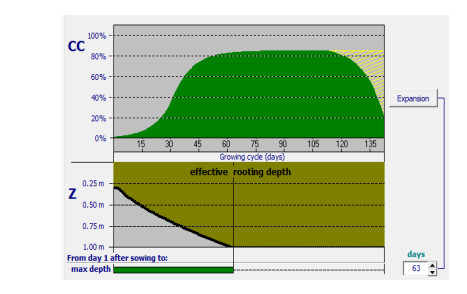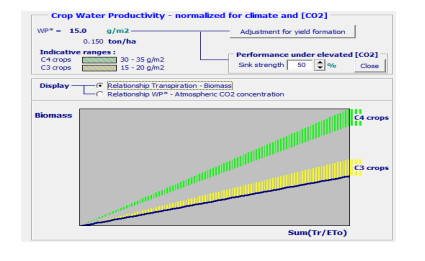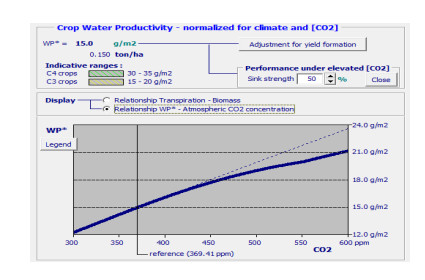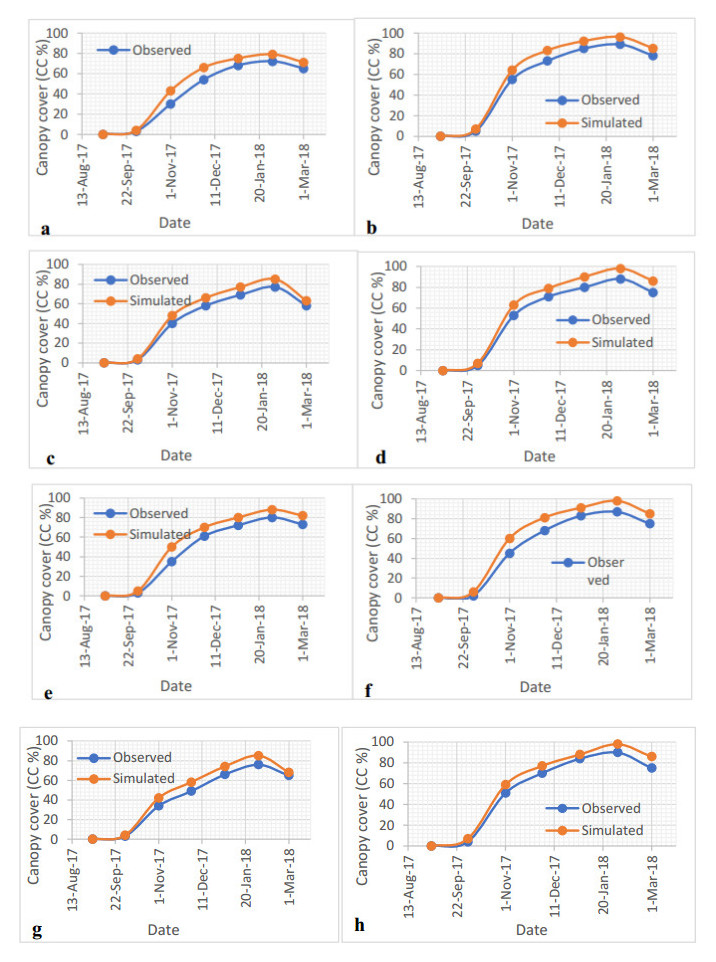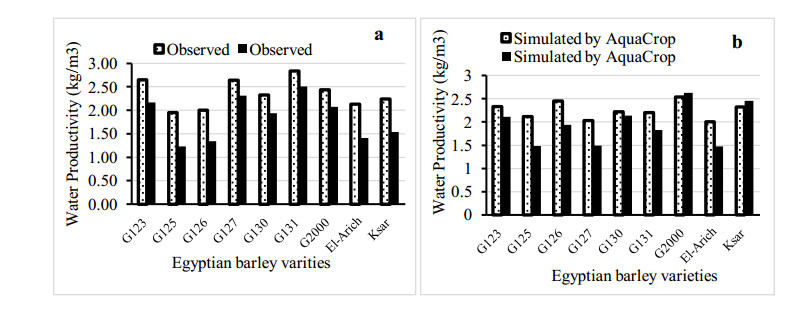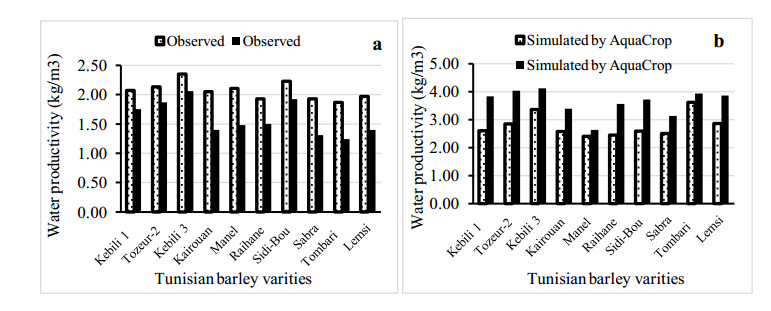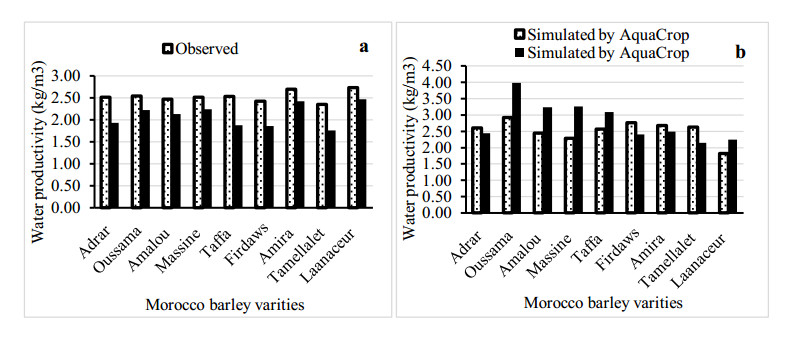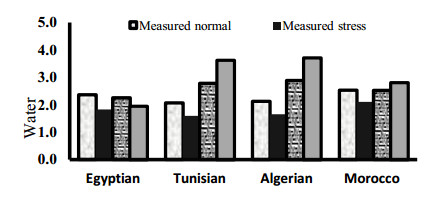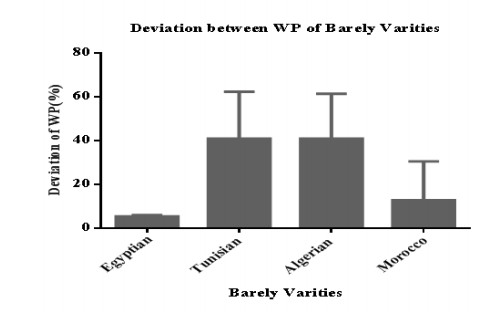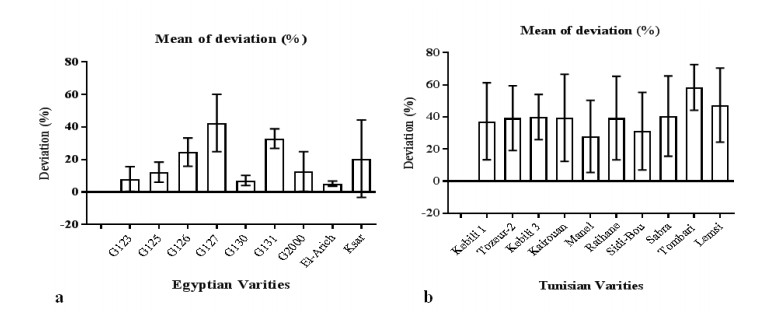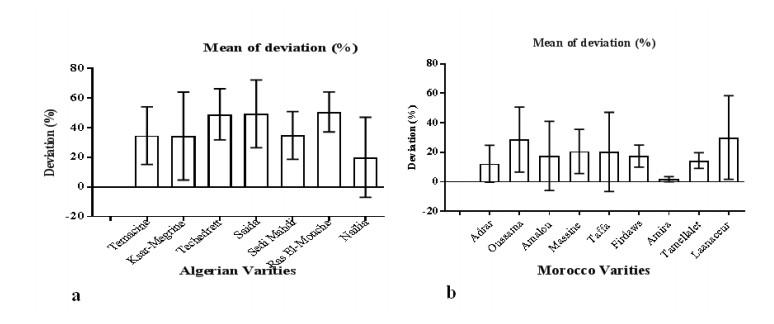Drought is the major a biotic stress that reduces plant growth and crop productivity worldwide. AquaCrop model is one of the most widely used simulation models, which simulates the growth, yield and water productivity of the crops. Field experiment was carried out in the Experimental Research Station of Nubaria, during two seasons of 2016/2017 and 2017/2018. The study to assess water productivity of Mediterranean barley (Egyptian, Tunisian, Algerian and Morocco) varieties grown under water stress condition (40% of water holding capacity) compared to normal one (75% of water holding capacity) by AquaCrop model. Deviations (%) between observed under normal irrigation water and observed water deficit (stress), AquaCrop model normal and AquaCrop model stress, data obtained were (2.36, 1.84, 2.25 and 1.59%) for Egyptian barley varieties, respectively. For Tunisian barley varieties, deviations (%) were (2.06, 1.59, 2.78 and 3.62%), respectively. For Algerian barley varieties, were (2.12, 1.66, 2.88 and 3.71%), respectively. The percentage of absolute difference between the percentage of variation in the case of water stress and the case without water stress treatment was 5.36% under Egyptian varieties, followed by Morocco varieties (12.78%). Egyptian varieties are the least tolerant of water stress treatment where the percentage difference in the absolute difference between the cases is equal to 25%.
1.
Introduction
Models can be defined as a simple or abstract representation of the real system. Model simulations typically go through a calibration phase, where the modeler is tuning a model by making comparisons with the observed data. Biological systems such as crops cultivation are very complex systems, making them a challenge to the model. However, because of crops, annuals crops, go through their complete life cycle in one year or a growing season, they belong to a repetitive biological system.
Barley (Hordeumvulgare L.) is the fourth largest cereal important crop worldwide, and it is also an excellent model species for the genetic and physiological studies [1]. Also, it's the unique genetic adaptation and the tolerance to a biotic stress is providing insights relevant to improvement in other cereal crops. Nevo and Chen mentioned that drought restrains of the crop production and the global food supply of crops often experience periods of the atmospheric or the soil water deficit, which are often accompanied by the high temperatures, poor nutrient uptake, and the outraged soil salinity stress [2]. The repeatable and reoccurring real systems can be validated independently making it possible to the develop models and continue to build on them year after year. The development of crop growth models began in the 1960s and have advanced and become more refined since, [3]. Three different simulation models, AquaCrop, SALTMED and SWAP, were used to predict the effective impact of both good irrigation management and irrigation water quality on crop yield, in this study, the accuracy of the use of these models on the maize crop was proven, [5]. The next section will provide the review of AquaCrop model used in this study.
The AquaCrop model is defined by Steduto et al. as canopy-level and the engineering type of the model, mainly focusing on simulating an attainable crop biomass and the harvestable yield in the response to water available [4]. The model was developed for purpose to using the fewer parameters in the balance of the simplicity, accuracy, and robustness. Water is used as main driver in AquaCrop for simulating yield production. Water is very important for crop production and was proven early on to be one of major limiting factors in crop growth. Crops use the water to carry the minerals, the sucrose and the hormones through the plant. Water is also very critical factor in the chemical reaction of photosynthesis [6]. Water-limiting conditions will result in the lower yields at the end of the season, so it is an important factor for crop modeling. The objectives of this research work are to evaluatethe water productivity of Mediterranean barley varieties under normal irrigation and water stress conditions by AquaCrop model.
2.
Material s and methods
2.1. Experimental field
Field experiment was carried out in the Experimental Research Station of Nubaria, during two seasons of 2016/2017 and 2017/2018. The study conducted to characterize the Mediterranean barley (Egyptian, Tunisian, Algerian and Morocco) varieties grown under water stress condition (40% of water holding capacity) compared to normal one (75% of water holding capacity).
Field experiment was carried out in the Experimental Research Station of Nubaria, during two seasons of 2016/2017 and 2017/2018. The study conducted to assess the water productivity of the Mediterranean barley (Egyptian, Tunisian, Algerian and Morocco) varieties grown under water stress condition (40% of water holding capacity) compared to normal irrigation (75% of water holding capacity) by Aquacrop model. The metrological data required by AquaCrop model are daily values of minimum and maximum air temperature, reference evapotranspiration (ETo), rainfall and mean annual carbon dioxide concentration (CO2). ETo was estimated using ETo calculator using the daily maximum and minimum temperature, wind speed at 2 m above ground surface and mean relative humidity (RH). Rainfall depths of 2.1 mm, 2.0 mm and 0.0 mm during the barley growth, all data obtained from the closest meteorological station at Wadi Al-Natroun City, El Buhaira Govornorate, Egypt.
2.2. Methods for data collection
Barley crop data was obtained from an experimental field. The experiment was laid in Randomized Complete Block Design (RCBD). Plots were 2.5 m × 6 rows with 0.20 m row spacing and sowing density was adjusted to 300 g m2. The crop component divided to 4 subcomponents including initial canopy, canopy development, flowering and yield formation and rooting depth. Both of yield formation and rooting depth were observed visually while the canopy was observed in field at regular intervals.
Geerts et al. and Farahani et al. used the following equation for estimate canopy cover [7,8]:
Where CC is canopy cover as shown in Figures 1 and 2. The relationship between Barley biomass water productivity and transpiration/ETo as shown in Figures 3 and 4. LAI is the leaf area index. LAI was calculated as LAP × NPM2, LAP being the leaf area per plant (m2), and NPM2 the number of plants per m2 [9]. Straw and grain yield were obtained from all plots after maturity from an area of 6 m2 in all cropping seasons.
2.3. The agronomic model (Aqua crop)
AquaCrop has four sub-model components: (ⅰ) the soil (water balance); (ⅱ) the crop (development, growth and yield); (ⅲ) the atmosphere (temperature, rainfall, evapotranspiration (ET) and carbon dioxide (CO2) concentration); and (ⅳ) the management (major agronomic practices such as planting dates, fertilizer application and irrigation if any).
AquaCrop calculates a daily water balance that includes all the incoming and outgoing water fluxes (infiltration, runoff, deep percolation, evaporation and transpiration) and changes in soil water content. The advantage with AquaCrop is that it requires only a minimum of input data, which are readily available or can easily be collected. AquaCrop has default values for several crop parameters that it uses for simulating different crops including wheat, however, some of these parameters are not universal and thus have to be adjusted for local conditions, varieties and management practices.
Where Oi: Observed values and Si: Simulated values.
The AquaCrop model uses the yield response to water equation (Eq 3) as a starting point for the model. AquaCrop evolves from this approach (Eq 3) by separating the evapotranspiration into crop transpiration and soil evaporation to develop a final yield as a function of the final biomass of the crop (Eq 4). This separation allows for distinguishing the effects on the non-productive consumptive use of water, soil evaporation, to better simulate crop growth. The water productivity (WP, biomass produced per unit of cumulative transpiration) is a conservative parameter, which is constant for given climatic conditions in Eq 3.
Where Yx and Ya are maximum and actual yield, ETx and ETa are maximum and actual evapotranspiration and key is the proportionality factor between relative yield loss and relative reduction in evapotranspiration.
Where B is the final biomass, WP is the water productivity (biomass per unit of cumulative transpiration), and Tr is the crop transpiration.
The WP parameter is based on the atmospheric evaporative demand and the atmospheric CO2 concentration for the purpose of being applicable to diverse locations and simulating future climate scenarios. Equation 5 shows the procedure for calculating the normalized WP based on adjustments to annual CO2 concentrations. This approach tends to over-simulate future crop yields caused by CO2 fertilization when compared to free air CO2 enrichment (FACE) experiments [10].
Where CO2 is the mean annual CO2 concentration and ETo is the atmospheric evaporative demand. The CO2 outside the bracket is the normalization concentration for a given year. Once the final biomass is calculated at harvest, the final yield output is the function of the final biomass (B) and the Harvest Index (HI). HI is the ratio between the harvested product and the total above ground biomass [11].
2.4. Calibration and validation model
AquaCrop is effective for modeling yields under a limited number of site locations. The current version of AquaCrop (6.0) has been assessed by the creation of two external utility programs called AquaData and AquaGIS [12]. AquaData acts as a database that contains all data necessary for creating input files used in AquaCrop. FAO have developed an AquaCrop plug-in program that will run AquaCrop without a user interface, which allows an application like AquaData to automatically run multiple crop simulations much more efficiently [13]. The AquaCrop plug-in program can be used for iterative runs for calibration purposes or for inputting into a Geographical Information System (GIS) for subsequent spatial analysis. Using similar methods, AquaCrop can be used for calibrating and analyzing long-term climate change impacts on crop yields in southern Alberta.
The drip irrigation system consists of the following components, as following:
Control head: It is located at the water inlet and consists of: Pump: Centrifugal electric pump (0.75 HP), n ≈ 2900 rpm and discharge 3 m3/h., Filter: Screen filter 1.5" (one unit), 155 mesh, Max. Flow 7.2 m3/h and maximum pressure 150 (PSI). Injection unit: Venture PE of 1" , rang of suction capacity 34–279 l/h., Measurement units: Spring brass non-return valve 2" , Pressure gauges, control valves and flow meter.
Main line: PVC pipe of 63 mm diameter-6 bar, connects the control unit to convey the water to sub main line: PVC 32 mm diameter line, delivered from the main line to feed the group of the laterals which represent treatments.
Pibars et al. and Mansour et al. designed drip irrigation system: Laterals: It is 16 mm diameter PE tubes, with 30 cm apart, built in drippers of 4 lph discharge at 1bar operating pressure. Distance between laterals was 0.9 m. Irrigation system design [14,15].
3.
Results
3.1. Canopy cover (CC%)
Figure 5 shows the effect of water stress and normal water (without water stress) on observed and simulated values by the AquaCrop program on the canopy cover (CC%) of barley varieties grown in Egypt and exported from four different Mediterranean countries (Egypt, Tuisia, Algeria and Morocco) under the drip irrigation system. The measured and simulated values up to maximum at the end of February and began to decline at the end of March.
The average of all Egyptian barley varieties observed and simulated values of (CC%) were recorded under water stress 72.79%, while 89.96% under normal water were recorded, respectively.
The average of all Tunisian barley varieties observed and simulated values of (CC%) under water stress recorded 77.85%, on the other hand under normal water, 88.98%, respectively.
The average of the Algerian barley varieties observed and simulated values of (CC%) recorded under water stress 80.88%, while under normal water recorded 87.98%, respectively.
The average of all Moroccan varieties observed and simulated values of (CC%) recorded under water stress 76.58% recorded 90.97%, respectively.
3.2. Egyptian varieties at harvest
Table 2 and Figure 6 showed the effect of both the use of the measurement method and the simulated use of the AquaCrop model on the water productivity estimated for the Egyptian barley varieties. Data on hand revealed that using the method of observed water productivity was the highest values in the case of normal drip irrigation system (75% WHC) or that exposed to water stress (40% WHC) (2.84 and 2.51 kg/m3) were recorded at Giza 131 variety, followed by values (2.65 and 2.17 kg/m3); (2.64 and 2.31) obtained after Giza 123 and Giza 127 varieties, respectively while, the lowest values of water productivity were recorded (1.95 and 2.34 kg/m3) after using Giza 125 variety.
On the other side: By simulated using AquaCrop model, results found that in case of normal condition of irrigation, the three highest yielding values of water productivity (2.54, 2.46 and 2.34 kg/m3) were recorded after Egyptian varieties; Giza 2000, Giza 126 and Giza 123, respectively. While the lowest one of simulated water productivity using the AquaCrop model was recorded at Arish variety (2.01 kg/m3). Whereas, under water stress condition, the highest simulated values using the AquaCrop model were recorded (2.63, 2.46 and 2.14kg/m3) at the varieties Giza 2000, Kasr and Giza 130, respectively.
3.3. Tunisian varieties at harvest
Table 3 and Figure 7 show the effect of both the use of the measurement method and the simulated use of the AquaCrop model on the water productivity of the Tunisian barley varieties. It was found that using the method of measurement was the highest values in case of normal condition under water stress condition (2.35 and 2.23kg/m3) were recorded at Kebili 3 and Sidi-Bou varieties, respectively, followed by values (2.44 and 2.39kg/m3) obtained at Kebili 3 and Sidi-Bou varieties while the lowest values of water productivity were recorded (2.06 and 1.92 kg/m3) after Manel varieties.
With respect to the AquaCrop model, the three highest yielding values of water productivity (3.61, 3.36 and 2.86) kg/m3 were recorded using Tunisian varieties (Tombari, Kebili 3 and lemsi), respectively under normal condition (unstressed). While the lowest value of water productivity using the model AquaCrop model was recorded (2.40) kg/m3 at Manel variety. While under water stress condition, the highest values using the model AquaCrop model were recorded (4.12, 4.03 and 3.93 kg/m3) at the varieties Kebili 3, Tozeur-2 and Tombari, respectively. These results are obtained using the AquaCrop simulation model.
Table 4 and Figure 8 showed the effect of both the use of the yield estimated data and the simulated by AquaCrop model on the water productivity of the Algerian barley varieties. It was found that using the method of measurement was the highest values in case without water stress or in the presence of water stress (2.27 and 2.18 kg/m3) were recorded at Ras El-Mouche and Nailia varieties, followed by values (2.18 and 2.15 kg/m3) obtained using Techedrett and Ksar-Megrine varieties. While the lowest values of water productivity were recorded (1.87 and 2.04 kg/m3) by at Sedi Mahdi and Temacine varieties. On the other side: After using AquaCrop model, It was found that in case of use without water stress, the three highest yielding values of water (3.85, 3.45 and 3.18) kg/m3 were recorded at Algerian varieties Ras El-Mouche, Techedrett and Saida, respectively. Whereas, the lowest value of water productivity after the AquaCrop model was gained at Sedi Mahdivariety (2.62 kg/m3). While under water stress, the highest values using the model AquaCrop model were recorded (3.18, 3.06 and 3.02) kg/m3 at the varieties Ras El-Mouche, Techedrett and Ksar-Megrine, respectively.
3.4. Morocco varieties at harvest
Table 5 and Figure 9 showed the effect of both the use of the measurement method and the simulated using of the AquaCrop model on the water productivity of the Morocco barley varieties. It was found that the highest values in case without water stress or in the presence of water stress measurement were (2.73 and 2.47 kg/m3) were recorded at Laanaceur variety, followed by Amira variety (2.69 and 2.42 kg/m3) while the lowest values of water productivity were recorded at Tamellalet variety (2.35 and 1.76 kg/m3).
On the other side: By using AquaCrop model, it was found that in case of use without water stress, the three highest yielding values of water productivity (2.92, 2.75 and 2.67) kg/m3 were recorded at varieties Oussama, Firdaws and Amira, respectively while the lowest value of water productivity using the model AquaCrop model was recorded Laanaceur variety (1.82 kg/m3) while under water stress, the highest values using the model AquaCrop model were recorded (3.98, 3.26 and 3.23) kg/m3 at the varieties Oussama, Massine and Amalou, respectively.
3.5. Comparison between barley varieties from some different Mediterranean countries
Figures 9 and 10 showed the comparison between different barley varieties from different African Mediterranean countries under water normal and stress or water deficit condition. One can notice that the most tolerable varieties of water stress treatment are Algerian varieties was 40.84%, followed by Tunisian varieties which recorded 40.83%. While the percentage of absolute difference between the percentage of variation in the case of water stress and the case without water stress treatment was 5.36% under Egyptian varieties, followed by Morocco varieties was 12.78%. Egyptian varieties are the least tolerant of water stress treatment where the percentage difference in the absolute difference between the cases is equal to 25%.
4.
Discussions
In Figure 11, the mean of deviation (%) between observed and simulated data of non-treated water stress showing that under varieties El-Arich and Giza 130 were obtained the low values (1.11 and 2.20%), respectively. In Egyptian varieties, the water productivity simulated by AquaCrop model under normal and/or stress condition was higher than the measurement cases under same Egyptian climate, water, soil, etc, of all condition. Whereas, the highest value was obtained at Giza 131 variety and the lowest one at Al-Arish variety.
Deviation of normal (%) between observed and simulated data showing that Kasr and Giza 2000 varieties were achieved the low values (3.72 and 3.94 %), respectively. On the other hand, deviation of stress (%) between observed and simulated data showing that El-Arich and Giza 130 varieties were achieved values (4.08 and 9.35 %), respectively, they were superior varieties for deficit tolerance. These results are obtained using the AquaCrop simulation model [4,16,17,18].
Regarding to the relationship between the observed values and the values of the AquaCrop simulation model as showed in Figure 11, it is possible to notice that in all Tunisian varieties, the water productivity in the AquaCrop model under both studied conditions was higher than the cases of measurement where the highest value obtained at the Kebili-3 verity and lower one at Manel variety. The mean of deviation (%) between observed and simulated data of water productivity showing that under varieties Sidi-Bou and Manel were the low values (27.93 and 31.16%), respectively. On the other hand, the deviation of unstressed (%) between observed and simulated data showing that Manel and Sidi-Bou varieties were achieved lowest values (12.04 and 14.08 %), and deviation of stress values were (2.63 and 3.13%) under Manel and Sabra varieties, they were the better varieties of deficit tolerance by drip irrigation system design [6,19,20,21,22,23,24,25,26,27,28].
The relationship between the observed values and the simulated model values as showed in Figure 12, it can be observed that in all Algerian varieties, the water efficiency of the Aquacrop model was reduced without stress and in the presence of water stress was higher than the measurement cases in the presence of stress and without water stress. The higher value was obtained under the Techetrett verity was obtained and the lowest value was obtained by using Nailia variety. The mean of deviation (%) between stress and normal water data of water productivity showing that under varieties Tamacine and Ksar-Megrine were the low values (34.61 and 34.33%), respectively. Deviation (%) of normal water and stress water between observed and simulated data showing that (Nailia and Ksar-Megrine); (Nailia and Sidi mahdi) varieties were achieved values (0.95; 13.32) and (39.12; 46.14 %), they were the better varieties of deficit tolerance [4,13,28,29,30].
In Figure 12, the mean of deviation (%) between observed and simulated data of water productivity showing that under Morocco varieties Amira and Adrar were the low values (1.21 and 12.30 %), respectively. Deviation normal (%) between observed and simulated data showing that the three lowest varieties were achieved values (0.54, 0.99 and 1.27) recorded under Amira, Amalou and Taffa. On the other hand, the three lowest values of deviation stress (%) were (2.97, 10.04 and 18.18) under Morocco varieties Amira, Laanaceur and Tamellalet, they were the better varieties of deficit tolerance. The water productivity of the Aquacrop model was reduced without stress and in the presence of water stress was higher than the measurement cases in the presence of stress and without water stress. The highest value was obtained when cultivating Oussama verity and lower value using Laanaceur verity. These results are obtained using the AquaCrop simulation model [28,29,31,32,33].
5.
Conclusions
AquaCrop model was applied to estimate water productivity of Barley varieties derived from Mediterranean countries (Egypt, Tunisia, Algeria and Morocco) under water deficit treatments. The study showed that very clear convergence of all data resulting from the use of the AquaCrop simulation program for the water productivity values with the corresponding quantities that were actually observed in the field during two successful seasons on examined barley varieties under drought conditions and water stress compared to the conditions natural water availability. So it is possible to recommend that using AquaCrop simulation program for different barley varieties in the future to predict the productivity of the water unit under semi-arid areas, especially in the case of water shortage using this program is based on the input of the most important (climate, soil and water data) outputs for the production data of the water unit, therefore it is possible to predict which will help to find suitable scenarios in case of climatic changes, water shortage or changes in soil characteristics.
Acknowledgments
The authors warmly thank the Agricultural Research in the Mediterranean Area 2 (ARIMNet 2) and Academy of Scientific Research and Technology (ASRT) and National Research Centre (NRC), Egypt who have funded this research work as a part of barley stress tolerance best project.
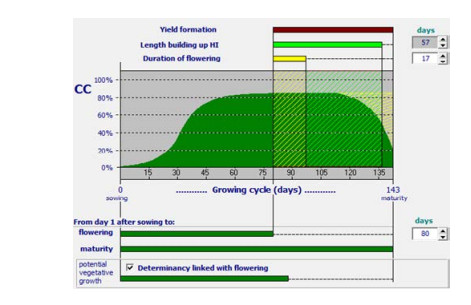









 DownLoad:
DownLoad:
